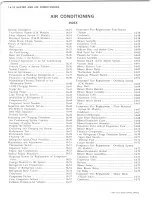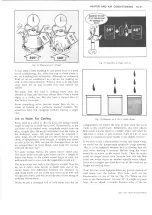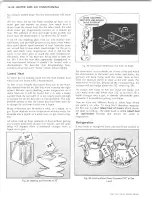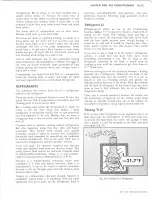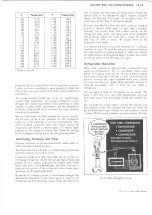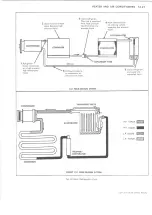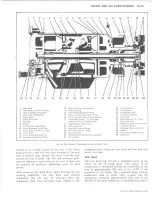
1A-32 HEATER A N D AIR C O N D I T I O N IN G
BALL SEATS USED
TO GIVE
.0005 TO .0010
TOTAL CLEARANCE
THRUST UNIT
CONTROLS
HEAD CLEARANCE
'* ^ 0 1 0
THRUST UNIT CONTROLS
RUNNING CLEARANCE
.0005 TO .0015
Fig. 36- General Running Clearances
high pressure from distorting the valves during the
pressure stroke of the piston.
Head to Shell Seals
Two large diameter "O" rings internally seal the front
and rear heads to the shell. A chamfered edge on the
head castings creates a squeezing action between the
discharge valve plates, the compressor, and the inside
surface of the shell.
Compressor Connector
Compressor connectors, are attached to the compressor
rear head by means of a single bolt and lock washer. All
have inlet and outlet connections connected by a strap to
form an integral unit.
G Models have gauge fittings located on the muffler and
compressor inlet line. Motor Home Chassis unit fittings
are located on the inlet and outlet lines. C-K model
gauge fittings are located on the accumulator and
evaporator inlet line. All fittings are equipped with a
valve core.
Pressure Relief Valve
The pressure relief valve, located on the compressor rear
head, is simply a safety valve designed to open
automatically if the system pressure should reach a pre
determined level high enough to cause system damage.
After the pressure drops to a safe level the valve will
close. After such an occurrence, the system should be
thoroughly checked to discover and correct the cause of
the abnormal pressure increase, and then should be
purged, evacuated and charged.
Refrigerant Lines
Special refrigerant hose lines are required to carry the
refrigerant liquid and vapor between the various system
components. The hose line with the smallest diameter is
called the high pressure liquid line. It is routed from the
condenser or receiver-dehydrator to the evaporator or
thermostatic expansion valve. The large diameter hose
line connecting the compressor and evaporator is the low
pressure vapor line. The large diameter hose between the
compressor and condenser is the high pressure vapor
discharge line.
These hoses are constructed with a synthetic material
core covered with a woven metal mesh which is, in turn,
covered by a woven fabric and coated for extra
protection. This hose is so constructed to withstand the
extreme pressures and temperatures found in the modern
refrigeration system.
None but special refrigerant type
hoses should be used.
All systems make use of swaged type connections (hose
to metal fittings) with metal to metal fittings being made
using "O" rings. Care must be taken when making these
connections that they not be turned down too tightly or
damage to the "O " rings may result.
Flexible refrigerant hoses should not be permitted to
contact the hot engine manifold nor should they be bent
into a radius of less than 10 times their diameter.
Muffler
A muffler, located in the high pressure line from the
compressor to the condenser, serves as a surge chamber
for high pressure gas to reduce the noise level of the
system while in operation. The muffler is actually a
welded portion of the compressor connector assembly. It
is found on all truck air conditioning systems.
Fan Slip Clutch
A special engine fan is used on most systems. It is an 18
inch five bladed fan, limited by means of a viscous
clutch to a maximum speed of 3200 rpm, regardless of
the speed of the engine. The silicone fluid in the clutch
transmits only enough torque to drive the fan at this
limited speed, thus avoiding excessive noise and power
consumption by the fan at higher engine speeds. A
temperature modulating device further limits fan speed
to 1000 rpm. until ambient tem perature at the
modulating device reaches 140°F. at which time fan
speed will be allowed to increase to 3200 rpm. Some
adjustment of the modulating device is possible.
Condenser
In a properly charged system, the condenser delivers sub
cooled liquid. This is because all the vapor condenses
before the end of the condenser and the remaining
portion of the condenser subcools the liquid.
Receiver-Dehydrator (G and Motor Home
Chassis Models)
The receiver-dehydrator, serving as a reservoir for
LIGHT DUTY TRUCK SERVICE MANUAL
Summary of Contents for Light Duty Truck 1973
Page 1: ......
Page 4: ......
Page 6: ......
Page 53: ...HEATER AND AIR CONDITIONING 1A 27 LIGHT DUTY TRUCK SERVICE MANUAL...
Page 115: ...LIGHT DUTY TRUCK SERVICE M A N U A L HEATER AND AIR CONDITIONING 1A 89...
Page 123: ...BODY 1B 3 Fig 6 Typical 06 Van LIGHT DUTY TRUCK SERVICE MANUAL...
Page 149: ...BODY 1B 29 Fig 84 Body Mounting 06 Fig 85 Body Mounting 14 LIGHT DUTY TRUCK SERVICE MANUAL...
Page 171: ...LIGHT DUTY TRUCK SERVICE M A N U A L Fig 2 Frame Horizontal Checking Typical FRAME 2 3...
Page 173: ...LIGHT DUTY TRUCK SERVICE M A N U A L Fig 4 10 30 Series Truck Frame FRAME 2 5...
Page 174: ...2 6 FRAME LIGHT DUTY TRUCK SERVICE MANUAL Fig 5 Underbody Reference Points G Van...
Page 185: ...FRONT SUSPENSION 3 11 Fig 16 Toe out on Turns LIGHT DUTY TRUCK SERVICE MANUAL...
Page 224: ......
Page 266: ......
Page 351: ...ENGINE 6 15 Fig ID Sectional View of Eight Cylinder Engine LIGHT DUTY TRUCK SERVICE MANUAL...
Page 375: ...EN G IN E 6 39 LIGHT DUTY TRUCK SERVICE MANUAL...
Page 376: ...6 4 0 ENGINE LIGHT DUTY TRUCK SERVICE MANUAL...
Page 377: ...ENG IN E 6 41 LIGHT DUTY TRUCK SERVICE MANUAL...
Page 378: ...LIGHT DUTY TRUCK SERVICE MANUAL Fig 37L K Series Engine Front Mount 6 42 ENG INE...
Page 400: ...6 6 4 ENG INE LIGHT DUTY TRUCK SERVICE MANUAL...
Page 401: ...ENG IN E 6 65 LIGHT DUTY TRUCK SERVICE MANUAL...
Page 402: ...6 6 6 ENGINE LIGHT DUTY TRUCK SERVICE MANUAL...
Page 403: ...E NG IN E 6 67 Fig 36V C Series Engine Mounts LIGHT DUTY TRUCK SERVICE MANUAL...
Page 410: ......
Page 423: ...EN G IN E C OOLING 6K 13 Fig 16 Overheating Chart LIGHT DUTY TRUCK SERVICE MANUAL...
Page 424: ...6 K 1 4 ENG INE COOLING Fig 17 Coolant Loss Chart LIGHT DUTY TRUCK SERVICE MANUAL...
Page 456: ...6M 32 ENGINE FUEL Fig K15 Accelerator Controls G Van L 6 LIGHT DUTY TRUCK SERVICE MANUAL...
Page 492: ......
Page 512: ...Fig 18e Vacuum Advance Diagram V8 Engine...
Page 516: ...6 T 2 4 E M IS S IO N CONTROL SYSTEMS LIGHT DUTY TRUCK SERVICE MANUAL...
Page 528: ......
Page 590: ......
Page 593: ...CLUTCHES MANUAL TRANSMISSIONS 7M 3 LIGHT DUTY TRUCK SERVICE MANUAL...
Page 598: ...7M 8 CLUTCHES MANUAL TRANSMISSIONS LIGHT DUTY TRUCK SERVICE MANUAL...
Page 642: ......
Page 654: ......
Page 743: ...FUEL TANKS AND EXHAUST 8 13 LIGHT DUTY TRUCK SERVICE MANUAL...
Page 744: ...8 14 FUEL TANKS AND EXHAUST LIGHT DUTY TRUCK SERVICE MANUAL...
Page 760: ...8 30 FUEL TANKS AND EXHAUST Fig 40 Exhaust Pipe P Models LIGHT DUTY TRUCK SERVICE MANUAL...
Page 761: ...FUEL TANKS AND EXHAUST 8 31 LIGHT DUTY TRUCK SERVICE MANUAL...
Page 763: ...FUEL TANKS AND EXHAUST 8 33 LIGHT DUTY TRUCK SERVICE MANUAL...
Page 766: ......
Page 832: ...LIGHT DUTY TRUCK SERVICE MANUAL Fig 106 Power Steering Pump Mounting Typical 9 66 STEERING...
Page 833: ...PUMP ASSEMBLY STEERING GEAR TYPICAL SMALL V8 TYPICAL LARGE V8 STEERING 9 67...
Page 861: ...STEERING 9 95 Fig 134 Power Steering Pump Leakage LIGHT DUTY TRUCK SERVICE MANUAL...
Page 864: ......
Page 876: ......
Page 886: ...11 10 CHASSIS SHEET METAL LIGHT DUTY TRUCK SERVICE MANUAL...
Page 891: ...ELECTRICAL BODY AND CHASSIS 12 5 LIGHT DUTY TRUCK SERVICE MANUAL...
Page 934: ......
Page 942: ......
Page 970: ......
Page 972: ......
Page 974: ......
Page 976: ...V...
Page 978: ......
Page 979: ......

